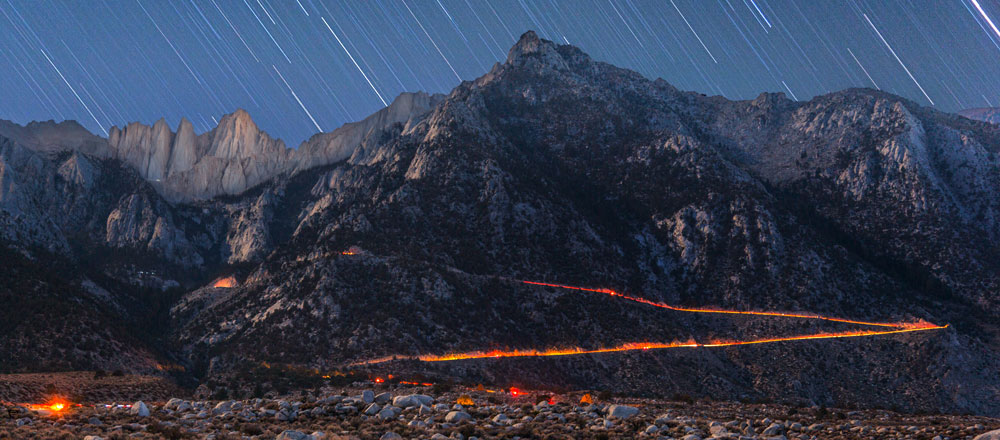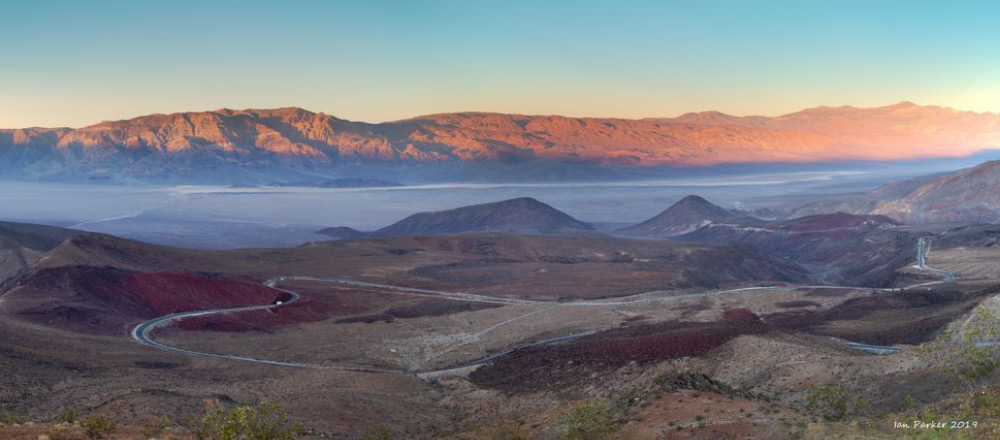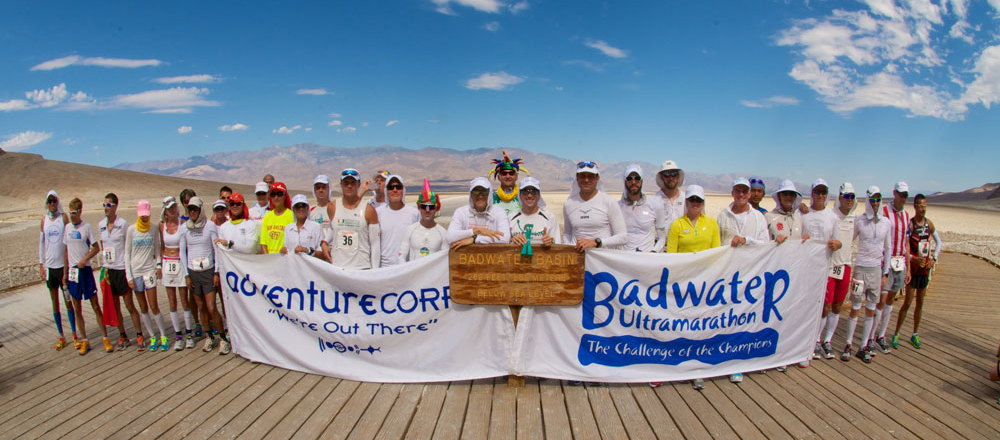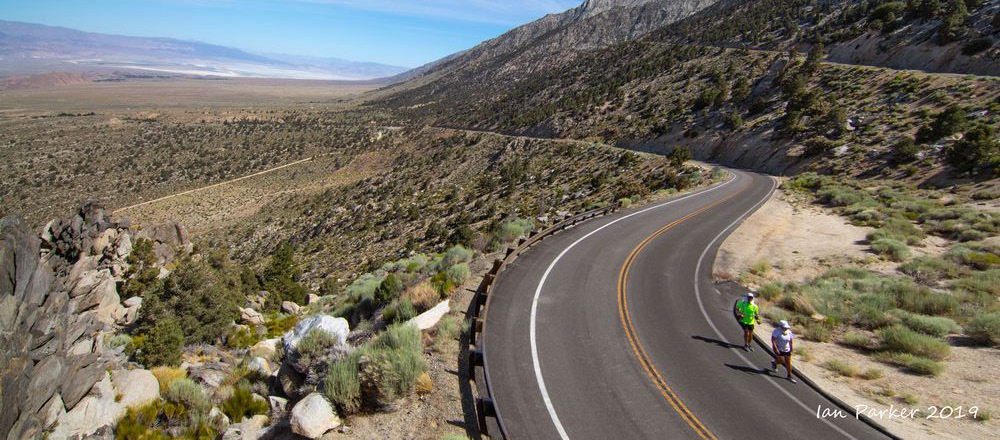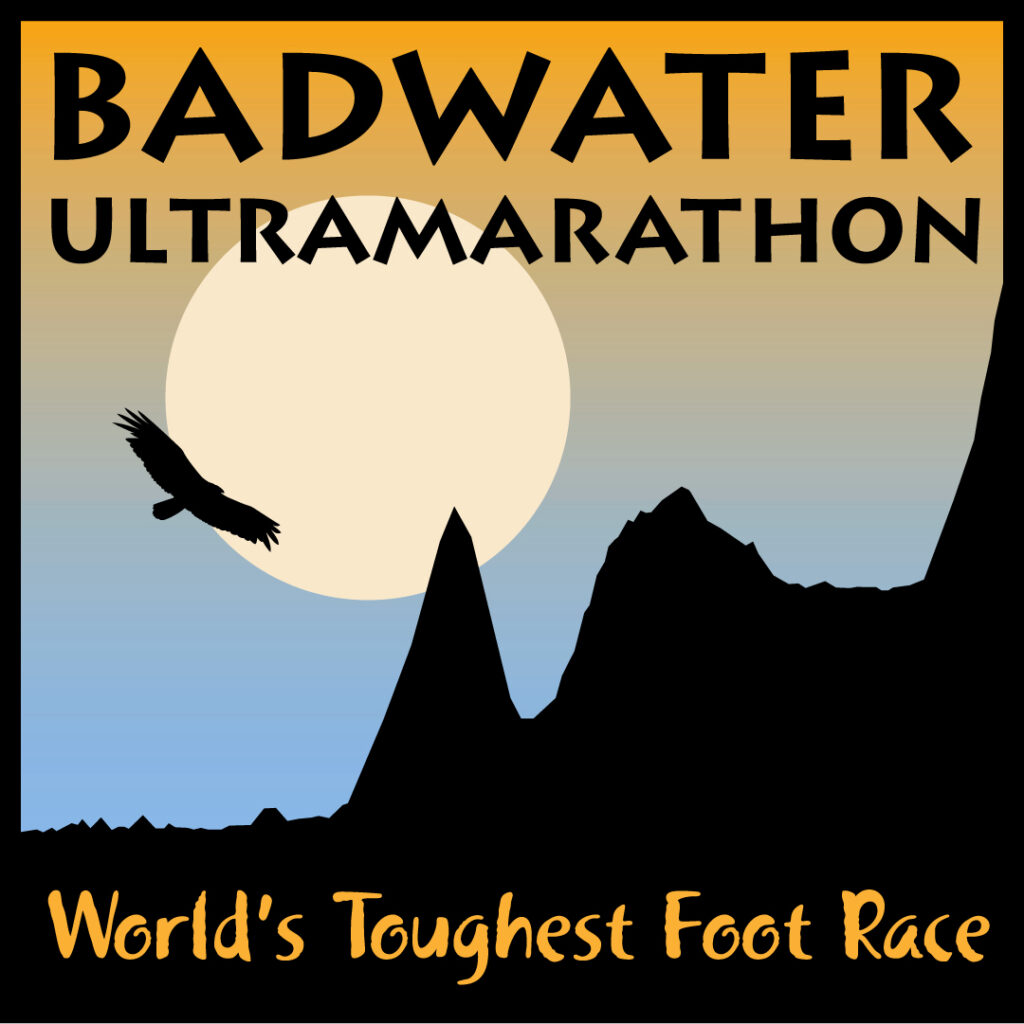Badwater 135 Race Rules & and National Park Service Regulations (2024 changes are noted in red.)
General Race Rules
- There are three starting times for the 2025 Badwater Ultramarathon (2000, 2100, and 2200 on July 7, 2025), but all Competitors in all waves are competing in the same race. Competitors must check in at the start line, ready to race, 30 minutes prior to their start time.
- Starting Groups are assigned by the race director and are non-transferable. Split times will be collated throughout the race to maintain overall standings. There are only two divisions: men’s and women’s. The Competitor to arrive at the finish line in each division with the lowest overall time, based on their starting time, will be considered the winner.
- The race number bib must be worn by the Competitor on the front of the body, unmodified, unfolded, and visible at all times during the race. It may not be worn on the head or hat. The Pacer Bib numbers must also be worn similarly by any Pacer / crew member who is running along with his or her Competitor.
- For the purposes of this event, nighttime is considered to be 1900 to 0700.
- All Competitors MUST have passed, and be proceeding beyond, the following locations along the race route within the specified time cut-offs:
• Mile 50.8 (2000′ Elevation Sign, located 8.6 miles beyond Stovepipe Wells): All Competitors must pass by 1000, Tuesday morning (regardless of starting wave).
• Mile 72.8 (Panamint Springs Resort): All Competitors must pass by 2000, Tuesday evening (regardless of starting wave).
• Mile 90.7 (Darwin Turn-Off): All Competitors must pass by 0500, Wednesday morning (regardless of starting wave).
• Beyond the Darwin Checkpoint, if it becomes clear that a Competitor will not be able to finish the race officially within the 48-hour time limit, that Competitor may be forced to withdraw from the course and the race prior to the actual conclusion of the 48 hours.
• Mile 122.8 (Lone Pine Dow Villa Motel): All Competitors must pass within 42 hours, based upon individual start time. - Competitors who fail to meet the specified time cut-offs along the course must withdraw from the race course; similarly, Competitors who are disqualified from the race must also withdraw from the race course. Such Competitors may not continue on the race course “unofficially” or after simply removing their bib number. Crew members from withdrawn Competitors must also depart the race course, unless they formally join another Competitor’s crew.
- The clock does not stop for any reason until the race course officially closes 48 hours after each designated official start time. All Competitors must leave the course by the 48th hour beyond their start time: Finishing, or remaining on the race course with the intent to continue, is not allowed after 48 hours.
- Running must always be single file, on the far left side of the road or off the left side of the road, facing traffic (Pacers, too).
- Competitors must make their presence known at all Time Checkpoints located along the route.
- As it has since 1989, the race ends at Mt. Whitney Portal. If any Competitor or crew member chooses to hike on the Mt. Whitney Trail, official race logos must not be worn and the appropriate permits must be obtained from the Forest Service.
- Competitors, crew, and staff must not litter, mar, or pollute the landscape or environment.
- All Competitors, crew and staff must display courtesy, good taste, decorum, and sportsmanship at all times. Nudity is specifically not allowed.
Legal and Bureaucratic Issues
- If the event is canceled due to pandemic, extreme weather, community disaster, or other force majeure, neither refunds nor credits will be given.
- Although we anticipate using the same route each year, the final, exact route is subject to approval from various government agencies and is always subject to change due to various factors beyond our control.
- BADWATER® is a federally registered trademark owned by AdventureCORPS, Inc. Personal crew t-shirts, fundraising shirts, and similar items may not have “Badwater” on them, or feature any version of the various official race logos and artwork. (“Death Valley” and “135” are good alternatives if you want to make special shirts for your supporters.)
- All applicants must be a minimum of 18 years in age when applying to race.
- All Competitors must follow and complete the entire application and entry process, filling out all forms and paying all necessary fees.
- Each Competitor’s Support Crew must have a designated Crew Chief and his or her name and email address must be provided to the race organizers at least eight weeks before the race. All crew chiefs must study all race rules and information about supporting a Competitor and organizing and overseeing a support team, as well as study all email correspondence sent by the race organizers. Each Crew Chief is to be primarily responsible for managing the support crew, maintaining adherence to all race rules, state and local laws, and common sense, as well as overseeing the Health and Safety of all crew members and the Competitor at all times.
- The names and email addresses of all support crew members must be provided at least four weeks before the race (preferably eight weeks.) All crew members must study all race rules and information about supporting a Competitor and organizing a support team, as well as study all email correspondence sent by the race organizers.
- Each Competitor is strongly encouraged to bring a nurse, EMT, MD or other first responder or medical professional on his or her support team.
- Each Competitor is strongly encouraged to bring at least one crew member or Crew Chief who is a veteran Competitor, crew member, or Crew Chief with Badwater 135 experience.
- Each Competitor is strongly encouraged to carry a walkie-talkie for communicating with his or her support crew.
- All Competitors and all crew members must sign the Accident Waiver and Release of Liability / Release of Name and Likeness. Each Competitor must also bring the properly completed Check-In Form and Medical History Form to Competitor Check-In.
- All race vehicles must meet the minimum requirements of property damage and personal injury liability automobile insurance for the State of California. All vehicle drivers must be fully licensed.
- All Competitors and all Crew Chiefs attend Competitor Check-In and the Pre-Race Meeting in Lone Pine, while all crew members are encouraged to attend both events. Additionally, all Competitors and all their Support Team must view the Online Pre-Race Meeting held prior to the in-person events in Lone Pine. (A code will be given out during the online meeting to prove it was viewed.)
- All Competitors must bring one U.S. dollar (or more) in a sealed envelope to Competitor Check-In. Please write the Competitor number on the envelope. This envelope will not be returned and the money will be donated to charity.
- During Competitor Check-In, all Competitors must display a minimum of two running-style reflective vests – which will be worn and utilized by the Competitor and Pacer (if a Pacer is used) during nighttime periods of the race – and a minimum of ten blinking red lights for all Competitors, Pacers, and crew members to wear at night. Competitors without satisfactory quality, or quantity, nighttime safety equipment, will be required to purchase additional gear at that time, IF any such gear is available.
- During Competitor Check-In, all Competitors must display one OSHA Class 3 reflectivity garment for each crew member to wear at all times during the event. See point 4 under “Support Crew & Assistance” below.
- During Competitor Check-In, all competitors must show that they have at least eight personal portable toilet products such as the Biffy Bag for use on the race course wherever toilets are not available. (Ziplocks or dog poop bags are NOT acceptable.) Such products must be used discreetly and must be disposed of properly after use. Public and/or unsanitary defecation by competitors or crew members will result in disqualification of the competitor. (To order Biffy bags with a 15% discount and which will then be available for pick-up during Competitor Check-In, use code BADWATER2024 at Biffybag.com and submit your order before July 10.)
- All Competitors must pay the Death Valley National Park Entrance Fee for their support vehicle. This is most easily done online, prior to coming to the race, at this link. (Print the receipt.) Proof must be brought to Competitor Check-In. Competitors will not be allowed to check-in for the race without proof of paying the Park Entrance Fee.
- No commercial photography or videography may be conducted at the race without the specific written permission of AdventureCORPS, Inc. Additionally, the National Park Service, California Department of Transportation and/or the U.S. Forest Service may also require commercial filming agreements. Also, bona fide media must contact AdventureCORPS, Inc. to request a media credential. All media, photographers, and videographers must attend the Media Check-In and Briefing prior to the race.
- PHOTO / VIDEO REGULATIONS WITHIN DEATH VALLEY NATIONAL PARK
The National Park Service – which has jurisdiction over the first 86.5 miles of the race route – regulates photography and videography if it makes an impact on Park resources or other Park visitors. Please visit nps.gov/deva/ for information. - All Competitors must be willing to submit to a drug urine test before (at any point prior to the race, after being officially confirmed for entry), during (at any time), or after the race (up to 90 days after the conclusion of the race). If any WADA banned substances are detected, the Competitor will be disqualified from competition, listed as DISQUALIFIED FOR DOPING in the final standings of the race and banned for life from any AdventureCORPS event. Refusal to submit a urine specimen upon demand will also result in the Competitor being disqualified from competition, being listed as DISQUALIFIED FOR DOPING in the final standings of the race, and being banned for life from any AdventureCORPS event. Additionally, any Badwater 135 finisher who fails a drug test within 36 months after competing in any edition of the Badwater 135 will be retroactively disqualified from any and all previous Badwater 135 races, removed from all Badwater 135 race results, as well as banned for life from any AdventureCORPS events.
Support Crew, Assistance, and Gear
- Each Competitor must be accompanied by a support crew comprised of no more than one four-wheeled motor vehicle and at least two and no more than four crew members – at least two of whom are legally licensed to drive and at least one of whom can speak English – at all times. Race Competitors may have no more than one support vehicle and no more than four crew members in total on the race course.
- The minimum age to be on a Badwater 135 support crew – or to ride in a support vehicle – is 13, with these additional conditions: a) Any crew member under the age of 18 (a “minor”) must have ultramarathon crewing experience, which must be submitted at least 30 days ahead of the race for consideration by the race organizers. b) The support crew must also include at least two adults who are licensed to drive. c) The parent or legal guardian of the minor crew member must also be on the support crew or be the runner for whom they are crewing. d) The parent or legal guardian of the minor must sign the event waiver on behalf of the minor.
- “Unofficial” or extra crew members and “family cheering squads” may only be present in Lone Pine and at the finish line; they may not drive on the race course except between Lone Pine and the finish line and that drive must be made without stopping. A secondary vehicle may not be used to shuttle crew members or supplies to and from the Competitor and support vehicle, except within Lone Pine.
- Each Competitor must have his or her own personal support crew and vehicle; crew and support vehicles may not be shared, except informally in the spirit of the event, i.e., crews may lend assistance to other Competitors or crews. (Exceptions may be made under some circumstances for married couples or others who have a history of racing together and would like to race with one shared crew. Please inquire.)
- ALL support crew members (except those actively pacing their Competitor) must wear OSHA Class 3 high-visibility / reflectivity clothing at all times during the event. These regulations may ONLY be met by wearing the special garments developed by ZZYXXZ in collaboration with BADWATER and which can be pre-ordered for pick-up at Competitor Check-In, OR by wearing certified OSHA Class 3 shirts. Here is an example which meets the Class 3 requirement. Please note: Class 3 garments have sleeves with reflective stripes, while Class 2 garments do not have sleeves with stripes. Also note: Running-type reflective vests, such as those by Nathan Sports, do NOT meet OSHA Class 3 requirements.This BADWATER ZZYXXZ t-shirt – short-sleeve, but with large reflective stripes on the sleeves – meets OSHA Class 3 reflectivity requirements for use during the event.
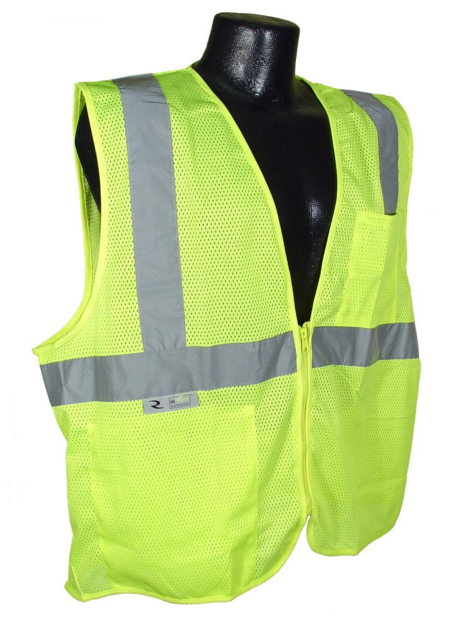 This generic “highway safety vest” meets OSHA Class 2 Reflectivity Requirements but NOT Class 3, and therefore it is NOT acceptable for use by crew members during the event.
This generic “highway safety vest” meets OSHA Class 2 Reflectivity Requirements but NOT Class 3, and therefore it is NOT acceptable for use by crew members during the event. - Competitors and Pacers may dress as they choose during daylight. At night, Competitors and Pacers must wear 360 degree reflectivity (such as reflective vests by Nathan Sports) and front and rear blinky lights. Competitors and Pacers are not required to wear the specific OSHA Class 3 garments that are required for all crew members, but that level of high-contrast reflectivity and visibility is highly recommended for Competitors and Pacers, too.
- In addition to the requisite reflective garments, all crew members, Pacers, and Competitors must wear front and rear blinky lights whenever they are outside of a motor vehicle during nighttime.
- Beginning immediately at the start line, Competitors must not run abreast with other Competitors or with Pacers, except when passing a slower Competitor, which must be done quickly. All running must be single-file. Additionally, Pacers may not run in front of, even slightly, Competitors at any time. (Pacers may run next to their Competitor briefly, when handing off supplies or spraying their Competitor, but only on the left side of the Competitor.)
- Competitors must progress under their own power without drafting (except other Competitors during the first few miles), helping, pushing, supporting, or any other type of physical assistance. Competitors may not use walking sticks, ski poles, or the like.
- So-called “cooling vests,” “cooling hats or visors,” or other types of artificial / technological cooling systems may not be worn or utilized by race Competitors while making forward progress on the race course. (Ice, wet towels, hand-held water sprayers or misters, and such are fine and commonly used. What is not allowed are products or technology whose sole purpose is to keep the Competitor “artificially cool.”)
- Neither Competitors nor Pacers / crew members may carry an umbrella or shade cover for a Competitor while the Competitor is moving forward on the race course.
- Competitors may not wear shoes with soles thicker than 40mm or that contain more than one carbon plate. Additionally, prototype shoes or shoes that are not on mass sale are not allowed. See an incomplete list of prohibited shoes here; it is the responsibility of the Competitors to ensure their shoes are allowed.
- Any crew member running along – for more than few moments – with their Competitor is considered a Pacer and must wear the Pacer’s designated number bib (provided at Competitor Check-In). If a Competitor is running with a Pacer, any additional crew members that are handing off supplies, or otherwise providing aid, must be off the roadway at all times (i.e. left of the white line on the shoulder) and may not run along with the Competitor and Pacer for more than a few moments.
- No more than two crew members, including a Pacer if one is present, may be on the other side (Competitors’ side) of the highway at any given time.
- Crew members, other than Pacers, may never cross the roadway during the entire Father Crowley climb (a 12.1-mile stretch from Panamint Springs Resort at Mile 72.8 to “Panamint Pass” at Mile 84.9), as described above. Also, each Competitor, or Competitor’s Pacer, is strongly encouraged to carry a walkie-talkie for communicating with the support crew during this 12.2-mile stretch of the race route. In addition to Badwater race staff, this will also be monitored by National Park Service staff who have the authority to disqualify Competitors.
- Competitors may not be accompanied by Pacers or moving crew members until Mile 42 at the Stovepipe Wells time checkpoint. Exceptions: Competitors 65 or older may utilize a Pacer from Mile 3.5 (Natural Bridge turn-off.) Blind Competitors may utilize a Pacer / guide from the start line.
- Wheeled conveyances (other than a motorized support vehicle), including in-line skates, strollers, and bicycles, are prohibited on the course at all times. Competitors accompanied by any such conveyance will be disqualified.
- Drones are illegal within Death Valley National Park boundaries.
- Crew members may not use illegal drugs, stimulants, or dope, as well as alcohol of any kind, during the race or at any official race events or activities.
Support Vehicles
- The California Motor Vehicle Code, and all local, county, and/or federal laws, rules, and regulations, must be respected at all times. In particular, support vehicle drivers and crews are reminded that phones must only be operated by the driver with a hands-free device; seat belts must be worn by all vehicle occupants at all times while moving, and it is illegal to drive on a highway while displaying emergency flashers. For further information, consult the DMV Code.
- Support vehicles may not be wider than 80″ in width (not including mirrors) or more than 84″ in height, per official manufacturer specifications. Minivans are most highly recommended, followed by medium sized SUVs. Oversize SUVs, extra large vans, large trucks, or other types of oversize vehicles are strongly discouraged (and usually not allowed.) Motorhomes, RVs, “SportsMobiles,” Sprinter Vans (and similar, such as the Ram Promaster), 15-passenger vans, and all types of Hummers are specifically not allowed. Support vehicles may not pull trailers of any kind. The largest vehicle currently allowed at the event is the Nissan NV3500, which is no longer made, as of 2022. (Ford Transit vans are also now too wide for use at the race.) See the Ideal Support Vehicle and Set-Up blog post for further information.)
- All Competitor support vehicles must have highly visible signage on the back of the vehicle stating “CAUTION RUNNERS ON ROAD.” Magnetic reusable signs may be ordered from our sign vendor (see below), or one-time use signs will be provided during Competitor Check-In.
- Sticky Competitor bib numbers will be provided to ALL Competitors during Competitor Check-In: these Competitor numbers must be displayed on all four sides of the support vehicle.
- Sponsor / Charity names and graphics may be placed on support vehicles on the left and right sides only, but NOT on the front or rear.
- Each Competitor may choose to also create or pay for additional vehicle identification signs. Our suggestion is to order standardized, professionally made signs for this purpose from the specific Los Angeles-based sign shop which which the race is affiliated. (See example below.) For those who order the signs from the specified LA sign shop, the race organizers will pick up all ordered signs immediately prior to the race and deliver them at Competitor Check-In. Click here for the Signage Order Form.This is an example of the custom sign you can order through an LA-based sign shop, which we will deliver to you at Competitor Check-In. These signs are OPTIONAL!
- Vehicle windows may not be blocked or obstructed with any signage, paint, or the like. No Competitor will be allowed to start the race who has any vehicle windows blocked. If a Competitor support vehicle is found with blocked windows during the race, that Competitor will be forced to stop and wait while the vehicle’s windows are unblocked and signage properly mounted.
- Vehicle Decoration: Vehicles may not have any additional red or blue lights added to them which are visible while the vehicle is moving. (Red and blue lights are reserved for law enforcement and first responders.) Additionally, inflatable pool toys and other large decorative items may not be mounted to the roof of the vehicle.
- Driving must be done at the speed of traffic, without slowing down to encourage, talk to, or lend assistance to any Competitor while moving. All assistance must be provided by pedestrian crew members; handing off of supplies from the vehicle is never allowed, nor is slowing down to speak with or to a Competitor or other person while moving. Vehicles must “leapfrog” the Competitor at all times. Each “leapfrog” should generally be about two miles in length, perhaps less on mountain ascents. Competitors may not be “shadowed” (driving a vehicle at the Competitor’s speed.) Driving may never be at the speed of any Competitor.
- All support vehicles must have their headlights on while driving, 24 hours a day.
- Vehicles must be parked completely off the road surface whenever they are stopped (with all four tires right of the white line). Many areas of the route have very little shoulder for parking so care must be taken in choosing stopping places. When stopping/parking, vehicles may not stop on the left side of the road, except in parking lots or exceptionally large pullouts. While stopped or parked off the road, support vehicles must have their headlights turned off and emergency flashers turned on.
- When parked, the doors on the left side of the vehicle must never be opened into the roadway. All exiting of the vehicle by active crew members must be from the right side of the vehicle; drivers may exit from left but only if space allows for them to do so without their door opening into the roadway. Crew members must not stand on the left side of a parked vehicle (between the road and the vehicle.)
- Support vehicles must not park across from parked vehicles on the other side of the road (50 meters in either direction), in order to avoid bottlenecking the roadway.
- Support vehicles may not stop during the one-mile stretch which begins at Harmony Borax Works at Mile 19.1, while Competitors pass through the curvy “Harmony Curves” section of Hwy 190. Each support vehicle should wait at Harmony Borax Works long enough to allow the Competitor to cover the next, mostly uphill, mile, then drive ahead (no stopping nor slowing fro, Mile 19.1 to Mile 20.1).
- On the Father Crowley climb (a 12.1-mile stretch from Panamint Springs Resort at Mile 72.8 to “Panamint Pass” at Mile 84.9), support vehicles may only stop at EIGHT designated locations along the route. These are identified in the route book and with signage along the roadway. Except in a legitimate emergency situation, stopping at any other location along this stretch of roadway, even momentarily, will result in the immediate disqualification of the Competitor associated with the stopped crew. In addition to Badwater race staff, this will also be monitored by National Park Service staff who have the authority to disqualify Competitors. (More details and photos.)
Safety and Medical Issues
- Remember, at all times and in all situations, safety is the most important issue. This means safety for Competitors, crew, staff, and the general public. The roads are not closed for this event and may be quite busy with tourist and local traffic.
- I.V.s (intravenous fluids) are not permitted during the race. If a Competitor receives an I.V. during the race, for any reason, then that Competitor is disqualified and must withdraw from the race and the race course.
- Competitors are responsible for both their own actions and their crew’s actions; crews are responsible for both their own actions and their Competitor’s actions.
- Always look and listen both ways before crossing the highways. Remember that drivers will not expect to encounter a Competitor or parked vehicle out on the course. Remember the event is held on public roads. Competitors should not cross over the highway more than necessary; crew should cross the highway carefully to bring assistance to their Competitor – except on the Father Crowley climb as noted elsewhere – rather than the Competitor crossing to the crew / vehicle. Time Penalties or Disqualification will be enforced with a Zero Tolerance Policy towards dangerous crossing of, or behavior on, the roadway.
- Per Park Service regulations, Competitors and crew members may not wear any headset covering the ears, or any earplugs in both ears, unless it is a necessary prosthetic device that aids the hearing-impaired.
- All competitors and crew must study “Medical Risks in the Badwater Ultramarathon,” “Dangers of Running in the Heat,” and “The Dangers of Hot Weather Running.”
Leaving the Course or Withdrawing
- Every inch of the course must be traveled by each Competitor. In the event of a routing error, e.g., wrong turn, the Competitor may be driven back to the exact original spot where he/she left the course and continue running from that location. There will be no allowance made for lost time or miles run in the wrong direction.
- If a Competitor needs to move up or down the course via motor vehicle, his/her crew must physically mark the exact location with a numbered stake in the ground. This numbered stake must be visible from the road in both directions. The Competitor must then resume the race from the same place that he/she left it. The numbered stakes will be provided to all Competitors at Competitor Check-In. Competitors may only leave or otherwise drive up or down the course via motor vehicle for medical attention, NOT simply to rest. This must be reported as soon as possible to Race Headquarters or the nearest time station. Competitors found in a moving motor vehicle will be disqualified unless they are en route to or from medical care. Focus must be kept on the speedy completion of the course.
- If a Competitor withdraws, he/she or his/her crew must contact Race Headquarters or a Time Checkpoint immediately. Name, bib #, reason for withdrawal, time of withdrawal, and miles completed must be stated. All Competitors and crew who withdraw from the race are encouraged – almost expected – to come to the finish line and the post-race party to greet and celebrate with their fellow Competitors and crews.
- All Emergency Medicine and/or Emergency Evacuation costs for Competitors, crew members, or staff will be borne by that person or their heirs. The race organizers are in no way liable for medical care, nor responsible for emergency evacuation.
Awards
- All Competitors who begin the event will receive a Badwater 135 race t-shirt, hat, Race Magazine, and a goodie bag with other one-of-a-kind Badwater items and products from the race sponsors, as well as entry into the post-race party (or the Competitor and up to four crew members. All Competitors who officially complete the event within 48 hours will receive a finisher’s t-shirt and commemorative Badwater 135 buckle.
Rule Enforcement and Penalties
- Race rules are designed to provide a safe and fair experience for everyone involved and to help ensure our ability to produce the race again next year.
- Major rule infractions by Competitors or their crew, especially those regarding “cheating,” will result in immediate disqualification of the competitor.
- Other, lesser offenses will result in the following cumulative time penalties:
- A WARNING may be issued, depending on the nature of the infraction, at the discretion of the race official (A “slash” will be marked on the Competitor’s bib.)
- First Penalty: 15 minutes in a few circumstances, but One Hour in most cases. (“X” will be marked on the Competitor’s bib.)
- Second Penalty: Disqualification
- Time penalties are imposed by the penalized Competitor stopping at the Time Checkpoint in Lone Pine to serve his/her time penalty. The race and clock will continue while the penalized Competitor waits out his/her penalty time. A Race Official will be present to oversee this process. Any Competitor who is required to serve a time penalty, but does not stop to do so, will be disqualified.
- The Race Director has the authority, at any time, to overrule any rule or invent a new rule based on extenuating, unforeseen, and/or unusual circumstances and/or to maintain the integrity and fair play necessary for the successful completion, and continuation, of the race. The Race Director has ultimate authority in regards to all rules, their interpretation, and their enforcement. There is no “appeals committee” nor an “appeals process.” All entrants in the race, and their support crews, willingly acknowledge this fact, as well as all other race rules, by attending the race in any capacity.
- In all cases and circumstances, it is the intent, and spirit, of the rules which will govern their implementation and enforcement.
Finally
- Have fun and keep smiling! Remember, you chose to be here!




